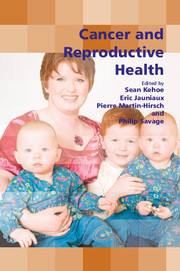Book contents
- Frontmatter
- Contents
- Participants
- Preface
- SECTION 1 Epidemiology, Genetics and Basic Principles of Chemotherapy and Radiotherapy
- 1 Epidemiology of cancer in women during reproductive life
- 2 Cancer genetics and reproduction
- 3 Chemotherapy in the treatment of pregnant women with cancer
- 4 Radiotherapy and cancer
- SECTION 2 Fertility Issues and Paediatric Cancers
- SECTION 3 Gynaecological Cancers and Precancer
- SECTION 4 Diagnostic Dilemmas
- SECTION 5 The Placenta
- SECTION 6 Non-Gynaecological Cancers
- SECTION 7 Multidisciplinary Care and Service Provision
- SECTION 8 Consensus Views
- Index
2 - Cancer genetics and reproduction
from SECTION 1 - Epidemiology, Genetics and Basic Principles of Chemotherapy and Radiotherapy
Published online by Cambridge University Press: 05 October 2014
- Frontmatter
- Contents
- Participants
- Preface
- SECTION 1 Epidemiology, Genetics and Basic Principles of Chemotherapy and Radiotherapy
- 1 Epidemiology of cancer in women during reproductive life
- 2 Cancer genetics and reproduction
- 3 Chemotherapy in the treatment of pregnant women with cancer
- 4 Radiotherapy and cancer
- SECTION 2 Fertility Issues and Paediatric Cancers
- SECTION 3 Gynaecological Cancers and Precancer
- SECTION 4 Diagnostic Dilemmas
- SECTION 5 The Placenta
- SECTION 6 Non-Gynaecological Cancers
- SECTION 7 Multidisciplinary Care and Service Provision
- SECTION 8 Consensus Views
- Index
Summary
Introduction
A small proportion of malignancies have a clear genetic aetiology resulting from mutations in genes inherited usually as an autosomal dominant trait. Women with or at risk of having inherited these mutations can have an increased risk of a variety of malignancies, and will often need to be entered into screening programmes. The wider family will also need to be assessed for an increased risk of malignancy and given advice regarding management of this risk. Risk assessment and genetic counselling around genetic testing and reproductive decision making should be undertaken in a regional genetic service. The majority of cancer predisposition syndromes are dominantly inherited, with the risk of passing on the mutation to children being 50%. There are a number of inherited predispositions to various malignancies (Table 2.1) but this chapter will concentrate on predisposition to gynaecological cancers. As with any genetic condition in which a pathogenic mutation has been identified, the reproductive options include:
▪ having children without any intervention
▪ not having children
▪ adoption/fostering
▪ the use of donor gametes
▪ prenatal diagnosis
▪ in certain situations, preimplantation genetic diagnosis (PGD).
Genetics of ovarian carcinoma
Ovarian carcinoma is the fifth most common cancer among women in the UK and the seventh most common cancer among women in the USA. There are a number of risk factors for ovarian cancer, including increasing age, early age at menarche, late age at menopause, delayed childbirth and low parity or nulliparity.
Keywords
- Type
- Chapter
- Information
- Cancer and Reproductive Health , pp. 13 - 22Publisher: Cambridge University PressPrint publication year: 2008



